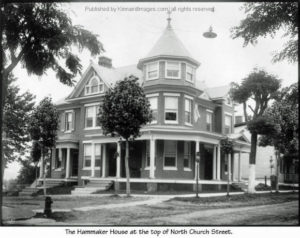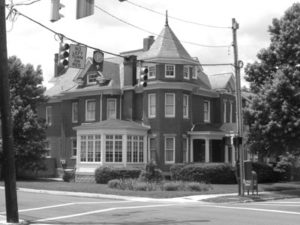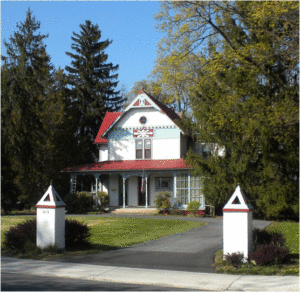by “My Father’s Son”
Around eight o’clock on August 27, 1925, Doctor Morris A. Birely was ushered by Lester Unger across the street from his home to the Thurmont house of Peter N. Hammaker at 26 North Church Street. Unger, employee and backyard-neighbor of Hammaker, had recognized the sound of an automobile motor running inside Hammaker’s locked garage and rushed to the doctor’s home. When the pair returned, Birely forced open the garage and recovered sixty-seven-year-old Hammaker, whom Unger had rightfully assumed inside.
Born in 1858, Peter N. Hammaker came to Thurmont in 1874, where he entered the marble and granite memorial business with brother, B. Frank Hammaker. Peter bought the entire Hammaker Bros. Memorial Company from his brother in 1878, when B. Frank relocated to Libertytown to start again in the same trade. Nine years later, Peter Hammaker wed Ida Miller of Lewistown on the morning of February 17, 1887. That same afternoon, elder brother B. Frank Hammaker wed Jennie Ensor. Peter, age twenty-nine, and bride Ida, twenty-eight, were wed nearly thirty years before Ida passed away of heart failure in 1916. Together, Peter and Ida endured the infant deaths of their only two children and constructed the stately “Hammaker House” at the summit of North Church Street that the couple moved to in 1908 (the new residence less than a dozen rods away from their former home, 106 N. Church St., sited with the Hammaker Bros. stone operations).
Two years later, in 1910, the Hammaker House’s near-duplicate was completed in Frederick City at 200 Rockwell Terrace; the comparable town residence was commissioned by Middletown native Oscar B. Coblentz, who came to Frederick upon his 1904 appointment as city Civil Engineer. In his lifetime, Coblentz would also work for the Frederick & Middletown, and WF&G Railways, act as Superintendant of Frederick County Schools, and be admitted to the Frederick County Bar after studying Law at the University of Maryland, while simultaneously tending his professional positions. August 1908 shifted Coblentz’s attentions to a new law practice, formed with Charles C. Waters after the death of Waters’ former affiliate, Chas. E. Cassell.
Coblentz and wife, Margaret Elizabeth Pontius (a student from Cochranton, Pennsylvania, attending The Women’s College of Frederick—renamed Hood College in 1912—whose first cousin, Joseph Henry Apple, was the College’s President), wed in 1903, and later purchased the first lot on Rockwell Terrace. Removed one block from the Women’s College’s 28-acre campus (donated in 1898), Rockwell Terrace was, and continues to be, the prestigious residential addition to Frederick, developed on the former land-holdings of Elihu Hall Rockwell. The Rockwell Street, extending W. Third St. westward, was laid out in 1905 after demolition of the Rockwell residence obstructing its path. The Coblentz home was begun in 1907 on Lot 2 and half of adjoining Lot 4.
The Hammaker and Coblentz homes exemplify the American- Victorian style, emerging after the Civil War. Residential Architecture authors, James C. Massey and Shirley Maxwell, describe this style as one that “popped up everywhere… in cities, suburbs, and rural areas.” Features of these homes’ Queen Anne sub-categorization include large, usually curvilinear wraparound verandas, balanced facades, turreted bay windows, many gables, and sporadic decoratively-shaped windows, usually maintained on even the simpler of Queen Anne constructs.
Many notable architects were drafting these desirable homes at the turn of the century. These Frederick County dwellings, however, appear less decorated than San Francisco’s Samuel & Joseph Newsom designs, less sprawling than Boston’s Peabody & Stearn’s, less “cottage” than Bruce Price’s New York clientele’s resort homes, and less palatial than the home plans of Philadelphia Hotel builders G.W. & H.D. Hewitt. The Hammaker and Coblentz residences seem more closely attuned to the blueprints of George F. Barber. Barber’s homes are present in all fifty states, and in countries such as Japan and the Philippines. Barber’s first catalog, released just before 1900, contained fifty-nine plans in the Queen Ann style. “Many Barber houses survive today—there’s probably at least one in a neighborhood near you.” (Massey, Maxwell)
No definite claim is laid that either of these homes is indeed of Barber creation, but suggests an educated point-of-reference. The primary differences between the Hammaker and Coblentz homes are the variations at the front porch (Coblentz’s reversed, allowing a large solarium), gable versus hip-dormered roof terminations, and, most noticeably, a greater footprint that deepens the Coblentz home by at least one room-depth overall—all differences difficult to identify when the homes are not viewed side by side. Overall, the finishes, window placements, grill patterns, and brick used unite the pair, their identical corner-bay towers their most revealing relation.
Oscar and Margaret Coblentz sold their home on December 31, 1917, moving with their five children to Baltimore. Mr. Coblentz was on the State Education Board. He was also a dedicated member of the Hood College Board of Trustees, a seat his son, Edward Coblentz, and daughter, Katharine Crook, sustained, leading Hood College to commemorate the family’s contributions with the Coffman Chapel memorial organ and pews, given in Oscar Coblentz’s name in the 1950s, and the Coblentz Memorial Hall dormitory that was dedicated in 1965. The Coblentzs are also recognized as “the first family to graduate three generations of Hood College students.”
Headlines on August 28, 1925, read “P.N. Hammaker Takes Own Life While in Garage – No reason assigned for act of well-known man.” Found unconscious inside his vehicle, Dr. Birely was unsuccessful in reviving Peter Hammaker. Contrary to the papers, neighbors Unger and Birely were likely aware that the day before Hammaker’s passing had not been a quiet one, as police warrants had been issued against Hammaker’s wife. Peter’s second wife, forty-one-year-old Mae Krise Hammaker (twenty-six years her husband’s junior) had instigated an altercation when she “sprinkled with water” an automobile parked along East Street’s curb beside the Hammaker home. When approached by the vehicles owner, a woman living adjacent the Hammakers, on the opposite North Church and East Street corner, was also “sprinkled with water” and hair “pulled from her head” during the ensuing row. Mrs. Hammaker was to be charged with assault and battery and use of improper language on a public highway. That evening and following day, Peter Hammaker was allegedly very distraught by the interaction between the women and so retreated to his garage. Whispers of a more-than-neighborly relationship between Hammaker and his unmarried, water-sprayed, 102 N. Church Street neighbor, were not unheard in town.
Hammaker’s business was sold to brother B. Frank Hammaker’s two sons, Peter’s nephews: Ernest P. and Frank E. Hammaker. Ernest and wife, Edith, purchased his Uncle Peter’s house for $7,500 to use as their residence. Come 1956, Ernest P. and Edith Hammaker completed construction of their modern, final home on land acquired by A.C. Sylvester, between Woodland and Clarke Avenues, where a stylized carving reading “Windy Woods, Ernest P. Hammaker” still stands. The retro-rancher, embellished with slabs of marble and granite, caused the sale of Ernest’s Uncle’s home, which was then owned by (among others) the Dr. Richard D. Culler family of Frederick, and later, U.S. Army veterinarians Jerry and Nancy Jaax, with whom the address gained notoriety as a momentary setting in Richard Preston’s 1995 best-selling book, The Hot Zone (chronicles the first Ebola outbreaks and the virus’s unsettling entry into a Virginia Monkey House).
The Hammaker House, as well as Peter’s former residence and Memorial Company facility, is nicely preserved between the Thurmont square and Western Maryland Railroad overpass. On Rockwell Terrace, Oscar B. Coblentz’s house had prospered handsomely as well and, although divided into apartments for several years, the home again serves as a single-family residence.
Note: For more pictures, follow Northern Frederick County’s history on Instagram at remembering_Frederick.

The Thurmont Hammaker House at 26 N. Church Street, built by Peter Hammaker and wife Ida in 1908.

The Frederick City Coblentz House on Rockwell Terrace, near Hood College, the Coblentz’s residence from 1910-1917.

 The house at 601 East Main Street in Thurmont is much more primitive in style than its neighboring Aurora Cottage. A simple square by perimeter, 601 is a 2-1/2 story, typical three-bay façade, differing from others in Thurmont of the same description by its forward-facing, steeply-raked front gable, allowing space for a largely habitable attic beneath the high-pointing rafters. One hundred and eighteen years old, this address is often known as “The Campbell House,” recognizing two scores of ownership by the surname. Removal of the columned wrap-around porch, asphalt-shingle siding, full-sized attic front-gable windows, and the replacement of the sash exchanged for the front door, the “Campbell place” is promptly exposed as Aurora Cottage’s lost Annex.
The house at 601 East Main Street in Thurmont is much more primitive in style than its neighboring Aurora Cottage. A simple square by perimeter, 601 is a 2-1/2 story, typical three-bay façade, differing from others in Thurmont of the same description by its forward-facing, steeply-raked front gable, allowing space for a largely habitable attic beneath the high-pointing rafters. One hundred and eighteen years old, this address is often known as “The Campbell House,” recognizing two scores of ownership by the surname. Removal of the columned wrap-around porch, asphalt-shingle siding, full-sized attic front-gable windows, and the replacement of the sash exchanged for the front door, the “Campbell place” is promptly exposed as Aurora Cottage’s lost Annex.